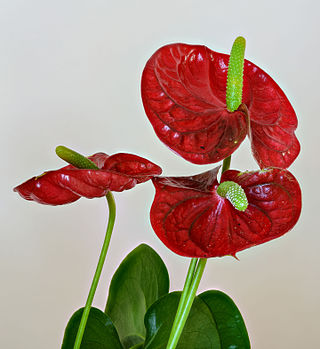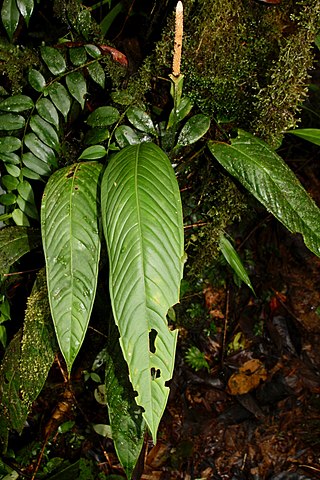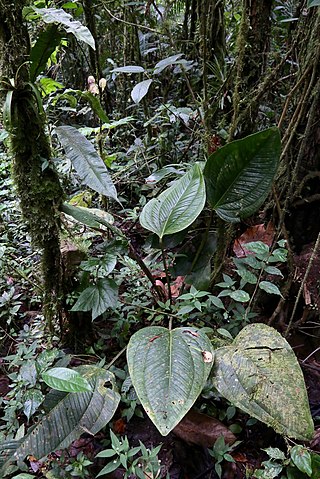
The Araceae are a family of monocotyledonous flowering plants in which flowers are borne on a type of inflorescence called a spadix. The spadix is usually accompanied by, and sometimes partially enclosed in, a spathe. Also known as the arum family, members are often colloquially known as aroids. This family of 140 genera and about 4,075 known species is most diverse in the New World tropics, although also distributed in the Old World tropics and northern temperate regions.

Anthurium is a genus of about 1,000 species of flowering plants, the largest genus of the arum family, Araceae. General common names include anthurium, tailflower, flamingo flower, and laceleaf.

Asarum caudatum is a plant native to rich moist forests of western North America. It has heart-shaped leaves and a three-lobed purplish flower.

Anthurium sect. Porphyrochitonium is a section within the genus Anthurium, which comprises about 250 species. Plants of this section are typified by Anthurium scherzerianum. The most definitive feature of the section is a large, bright red spathe. Other than this distinction, it shares nearly every other characteristic with section Urospadix. Anthuriums that belong to Porphyrochitonium are generally delicate in appearance, bearing slender stems with short internodes and elongated, non-cordate leaf blades which are glandular-punctate on at least one surface. There are one or more well-defined collective veins, and the berries generally have three seeds.

Philodendron melanochrysum is a species of flowering plant in the family Araceae, endemic to the wet Andean foothills of Colombia, growing at approximately 500m above sea level in the provinces of Chocó and Antioquia but widely cultivated elsewhere as an ornamental.

Anthurium warocqueanum, commonly known as the Queen Anthurium, is a species of plant in the genus Anthurium. Native to Colombia, it is grown in more temperate climates as a greenhouse specimen or houseplant for its ornamental foliage.

Anthurium pedatoradiatum or Anthurium Fingers is a species of plant in the genus Anthurium native to southern Mexico. A. pedatoradiatum has leaves with deep finger-like sections, and is terrestrial. Its natural habitat is from sea level up to 1,000 meters (3,300 ft) in the Mexican states of Veracruz, Tabasco, and Chiapas. It is related to other Anthurium in the section Schizoplacium such as Anthurium podophyllum, and its species name in Latin refers to the radiating growth of its palm-like leaves.

Anthurium forgetii is a species of plant in the genus Anthurium native to Colombia. Kept in cultivation for its round leaves that lack a sinus and have silver veining, it is thought to be epiphytic.
Thomas Bernard Croat is an American botanist and plant collector, noteworthy as one of botanical history's "most prolific plant collectors". He has collected and described numerous species of plants, particularly in the family Araceae, in his career at the Missouri Botanical Garden.

Anthurium oxycarpum is a species of flowering plant in the genus Anthurium. It can be found in Central and South America from southeast Colombia to Bolivia and northern Brazil. One of the "birds nest" Anthurium species, it grows terrestrially. In its native land, the dried leaves–which smell fragrantly like vanilla and musk when dried–are sometimes smoked or used as snuff.

Anthurium magnificum is a plant in the genus Anthurium native to Colombia. Closely resembling other Anthurium species like Anthurium crystallinum, it has large, cordate leaves with prominent veining and is primarily terrestrial. Plants of the true species can be distinguished primarily by their quadrangular petioles.

Anthurium clidemioides is a species of plant in the genus Anthurium native to Costa Rica, Panama, and Colombia. One of the more distinctive Anthuriums, it is a vining climber with almost stalkless, bullate leaves that can range from light to very dark green. Along with Anthurium flexile it is one of only two species in the genus that produces roots between nodes.

Anthurium podophyllum is a species of plant in the genus Anthurium native to coastal areas of the Mexican states of Veracruz and Oaxaca. A terrestrial species, it grows in tropical forest understories in seasonally dry areas. It is named for its palmate leaves that somewhat resemble plants in the (unrelated) genus Podophyllum, and which have many subdivisions. It is related to other terrestrial Anthurium with similar leaf morphology in the section Schizoplacium, such as Anthurium pedoradiatum, and produces orange berries.

Anthurium microspadix is a species of plant in the genus Anthurium. Growing as an epiphyte or a terrestrial shrub, it is native from the southern Mexican states of Oaxaca and Chiapas to Bolivia from 800–2,300 metres (2,600–7,500 ft) in elevation. One of the more widely distributed and variable species in its genus, it is easily confused with species such as Anthurium pallens and others.

Anthurium pallens is a species of plant in the genus Anthurium. Growing as a climbing epiphyte with short stems and usually pendent growth, it is native to Central America. Easily confused with other species such as Anthurium microspadix, it can be distinguished by its typically shorter branches and leaf blades acute to rounded at the base.

Anthurium formosum is a species of plant in the genus Anthurium native to Central and South America. Epiphytic or terrestrial, it is found from Nicaragua to Colombia and northwest Venezuela.

Anthurium argyrostachyum is a species of plant in the genus Anthurium native to Ecuador and Colombia. Growing as a small shrub or an epiphyte, it is best recognized by its foliage that has triangular or arrowhead-like shape, a long central lobe, and parallel veins. It is a member of the section Polyneurium, and is thus related to Anthurium corrugatum, Anthurium panduriforme, and others that share its parallel venation and other characteristics.

Anthurium coloradense is a species of plant in the genus Anthurium native to Panama. A member of the section Polyneurium, this terrestrial shrub is most recognizable by its thin, veined leaves and its yellow-green spadix. Its foliage is very similar to other Panamanian species such as Anthurium caperatum, Anthurium santamariae and Anthurium cerrosantiagoense but may be distinguished by details such as the grooves in its stems and the pattern of veining, with the collective vein growing from the third vein in a leaf.

Anthurium wendlingeri is a species of plant in the genus Anthurium found in Central and South America, from southeast Nicaragua to northwest Colombia. It grows in wet tropical habitats as an epiphytic shrub with long, pendant leaves up to 7 feet (2.1 m) long that can have a slightly velvety appearance.

Anthurium ovatifolium is a species of plant in the genus Anthurium native to Colombia, Ecuador, and Peru. It grows in wet tropical habitats, and is a member of the section Digitinervium. Its species name refers to the oval shape of its leaves, and it can be distinguished from similar species like Anthurium lentii by its red berries.



















